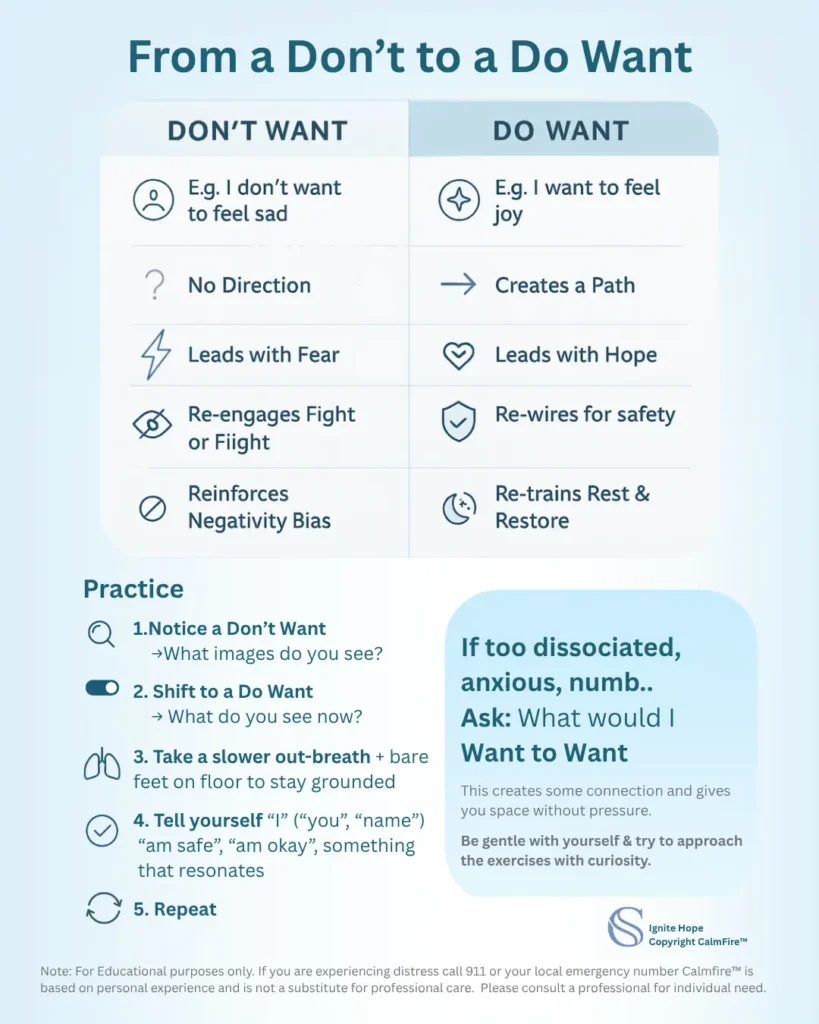Start Healing Your Nervous System | 1 Actionable Mindset Shift
Jump to: The Negativity Bias | The “I Can” Shift | What Does Your Mind See? | Rewiring The Brain’s Focus | Why This Matters: 3 Contexts | What Happens with “Not Wants” | The Twist With Complex Trauma | Try This MindShift | Dealing With Resistance | Final Thought
Download: Actionable Mindset Shift Here
An Actionable Mindset Shift to Help Heal Your Nervous System
For a while, I had been living with milder complex trauma symptoms without even knowing it. It wasn’t until 2020 when I started experiencing severe daily symptoms that I started actively and urgently looking for a solution. One of the first and simplest mind shifts that I started engaging in for my nervous system was this:
Instead of focusing on what you don’t want, start focusing on what you do want.
I was thinking so much in terms of: “I don’t want to feel like this”, “I don’t want to feel anxiety”, “I don’t want this unfairness”…
And while this is exacerbated in Complex Trauma, it’s also how our brains are wired. It is not conducive to healing the nervous system.
As humans, our brains have not evolved much past our primitive needs (1. Negativity Bias). We are still deeply wired to focus on danger, on what might hurt us, and on avoiding pain.
The Negativity Bias
Negativity Bias(1), briefly: our brains notice danger more than safety. Repeating “don’t want” thoughts teaches your attention to look for what is wrong, which then confirms the worry and keeps your system activated.
For instance. You “don’t want to feel lonely” so you try to smile at someone but they don’t smile back. You notice this and it “re-confirms” your percieved notion that you are alone, even though that person may just not have noticed.
And while, this is helpful when we are trying to avoid real dangers, it’s not particularly helpful in our every day more modern lifestyle. It shows up in all areas of life, from the very small to the deeply personal.
Some other examples of what you might be telling yourself are:
- I don’t want to feel so anxious
- I’m tired of feeling afraid
- Feeling alone sucks
These look different but the core remains the same. And, some are even more hidden like:
- I want to stop feeling pain
- I want to stop feeling sad…
These look like “Wants” but they’re just “Not Wants” in disguise.
At first, those all sound reasonable. Right? Nobody wants these things. But if you look closely, every one of them is about stopping something.
The brain doesn’t know where to go next, it only knows what to avoid. And with this messaging, it doesn’t even know where or how to begin. There is no clear path here.
What I’ve found incredibly helpful is doing the opposite: focusing on what it is you do want. This does change the mental imagery. This does start a path.
The “I Want” Shift
Try some these shifts:
- Instead of “I don’t want to be in pain,” → “I want to feel whole.”
- Instead of “I don’t want to feel sad,” → “I want to feel joy.”
- Instead of “I don’t want to be lonely,” → “I want to feel surrounded.”
Some are trickier, because they sound like wants but are still “not wants” in disguise:
- I want the pain to stop → I want to feel at peace.
- I want the unfairness to stop → I want to feel secure.
If you can, take a second to see if this resonates with you, even a little, and notice the difference between the two.
What Does Your Mind See?
In one case, you are avoiding and pushing something away. You’re picturing that “don’t want”, the pain, sadness, or loneliness, over and over in your head.
This can be a mental picture of you crying or curled up on a couch. It can also be replaying difficult moments over and over in your head.
Purposefully doing this is different than flashbacks or emotional flashbacks which can hijack your system2. However, I believe staying in a state of “I Can’t” and “I Don’t Want” keeps you in fear which may lead to a state where flashbacks can occur.
Rewiring the Brain’s Focus
With these pictures and these words, your body likely reacts to the emotions that come with it.
Yet still, you don’t have a direction. You don’t have a path, and you don’t have any calm or reassurance or power there.
In the other case, you are picturing something you can move toward. You’re creating an image of what you want, and that gives your brain and body a clearer path and instruction to follow. (I will touch on anxiety in Complex Trauma a bit later).
Focusing on what you want creates a path.
It gives your nervous system somewhere to go instead of something to fight against.
Why This Matters | 3 Contexts
1. Anti-War Vs. Pro-Peace
The imagery changes. Your system begins to move forward easier.
While they might sound similar, “anti-war” movements and “pro-peace” movements feel completely different as do their accompanying mental images. The same energy shift applies inside you.
2. The LifeGuard
The instruction is clear and simple.
Think of the difference between a lifeguard shouting “Don’t run” and one saying “Walk.”
Even though “don’t run” sounds clear, you still picture someone running. “Walk” gives the brain a specific image and direction. Both sentences imply they want the same result but the latter works better.
3. The Classic “Pink Elephant”
You give yourself a destination.
The same is true when you hear “Don’t think of a pink elephant.”
Of course, the first thing you picture is a pink elephant.
Actually regardless of whether I say “Don’t Think of a Pink Elephant” or “Think of a Pink Elephant”, you’ll picture a pink elephant.
But if I say “Think of a blue llama,” your mind shifts instantly to a new image.
This is how your thoughts guide your nervous system. When you say, “Stop being depressed,” your brain still sees depression and doesn’t know what to do next. When you say “I want to feel joy”, you’ll picture that instead and now:
It’s simple, but powerful. That forward movement creates orientation, and that orientation starts healing.
It can also help you break out of habitual mind loops and habits. In turn, this leads to more healing for your nervous system.
What Happens When You Think in “Not Wants”
When you are constantly thinking in “not wants,” your body and nervous system stay on alert. It is much harder to engage in healing the nervous system.
You are subconsciously scanning for potential threats to avoid.
This keeps your system wired and tired because your motivation is fear.
What we want instead is to teach the body how to aim for safety.
When the nervous system learns that calm is safe, not dangerous, the body can finally begin to relax.
There are of course other things that go into this but for the purpose of this post and to keep it simple, this is one powerful tool to add to your arsenal.
A Twist: Complex Trauma
If you live with Complex PTSD, this shift can be more complicated.
There might be moments when you think to yourself, “I don’t know what I want.”
“The great thing, then, in all education, is to make our nervous system our ally instead of our enemy.” ~ William James
Or maybe you feel so shut down and dissociated that even joy sounds scary, unrealistic, or you may not remember what it’s like.
With CPTSD you might think: “I don’t want joy”, or “I don’t want to be around others, I do want to be alone”.
And while yes, time to yourself is important, I think we can recognize, at least sometimes, that those messages are not always what they seem.
In CPTSD especially, it comes from having been hurt, feeling like an outsider, rejection and/or having comfort ripped away.
Gently Retraining Your System
If this sounds familiar, and you feel like you don’t have any “wants” that have hope, please know this can be part of Complex PTSD recovery.
Your body is still trying to protect you from further pain in the only way it knows how. It might fear healing because healing means change, and change, even positive change, can feel unsafe.
When we start to change, discomfort is normal. The nervous system is learning something new.
So, start gently.
You can focus on what you would logically think you would want as a human being who deserves love, peace, and belonging.
And if that still feels too far, try this question:
“What Would I Want to Want?”
This creates a little distance between where you are now and the idea of change.
That distance helps your nervous system guard down just a little. It allows curiosity without pressure.
Even 1% of openness is enough to begin.
Try this Mindset Shift
Practice
Like most healing work, this isn’t about perfection, it’s about practice.
You can start simply:
- Notice your Don’t Wants: When you catch yourself saying, “I don’t want to feel this way,” pause. (Remember the hidden ones.)
- What do you see? Try to do this with detachment and curiosity.
- Reframe into Do Want: Ask, “What do I want to feel instead?”
- Notice what you see now. Be curious about this too.
- Add breath or grounding. Picture or say your new phrase slowly. Keep a slower out-breath to help stay regulated. Notice your bare feet on the floor to stay grounded.
- Say to yourself: I (or you, your name) “I am safe”, “I am okay”, or anything that does or would resonate with you
- Repeat
- If you’re feeling a lot of resistance, dissociation, numbness etc., then try this: think of what You’d Want to Want.
- This creates some safe distance for you but still keeps a connection without pressure.
Each time you do this, you teach your brain and body what calm feels like.
Over time, these moments build new pathways that favor regulation and self-trust.
This is not about pretending everything is fine. It’s about helping your body learn safety and direction, one thought at a time.
Dealing with Resistance
When you are making a change, really for humans but especially in Complex PTSD, you may encounter the following thoughts:
- This may work for others but not for me, My pain is worse/different, etc.
- What may help you here is to remember that change is part of recovery and your body is trying to protect you even if it’s maladaptive
- Thank yourself/body/mind and gently continue if you can. Try to remain open and be curious about reactions as they occur.
- These are wounded parts of you that need healing, hope and tenderness.
Final Thought
Healing your nervous system isn’t about erasing the past.
It’s about giving your body and mind new instructions, ones that lead toward safety instead of away from fear.
You don’t have to see the whole path yet.
You just have to start with one step:
“I want to feel peace.”
“I want to feel whole.”
“I want to feel safe.”
That small shift is where healing your nervous system can begin.
Warmly
Allie C. | CalmFire™
If this helped you in any way, support it. Your gift helps keep CalmFire™ free and accessible to those who need it most. Thank you.
✨Support CalmFire™ on ko-fi.com/thecalmfire or use the box on the top of the sidebar.
Recommended Links: Downloadable Word Bank
Recommended External Reading: If you’d like to learn more about the Negativity Bias try VeryWell Mind
For more information on Flashbacks this is from Bessel Van Der Kolk’s Page
Note: I’m not a licensed professional. I’m sharing from my own healing journey and these are tools that have helped me personally. Please give yourself and others space and patience along the way. This blog is for support, not a substitute for professional care. If you are in crisis, call 911 or your local emergency number.


You Got This
Inner Critical Voice (Part 2): The Hidden Non-Verbal
Inner Critical Voice (Part 2): The Hidden Non-Verbal Side The…
Negative Self Talk Examples (Part 1): The Obvious Inner Critic
Negative Self Talk Examples (Part 1): The Obvious Inner Critic…




